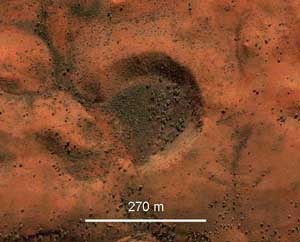The Hickman Crater, located in the Pilbara region around 1000 km northeast of Perth, was named for its discoverer, Arthur Hickman, who was using Google Earth to conduct research on channel ore deposits.
If confirmed, the Hickman Crater will be Australia's second largest preserved rim crater - one that has not eroded significantly from its original shape. The crater's rim, which is 80 per cent preserved, stands 30 m above its floor, and consists mainly of rhyolite, a rock similar to granite.

|
| ©Google Earth |
| The Hickman Crater as viewed from satellite |
An estimated 10,000 to 100,000 years old, the crater has an average diameter of 260 m and depth of about 50 m. Of Australia's preserved rim craters it is second in size only to Wolfe Creek crater in Western Australia, which measures 875 m across and is 60 m deep.
Sifting through the evidence
Hickman, a geologist at the Geological Survey of Western Australia, recruited impact crater specialist Andrew Glikson, a visiting fellow at the Australian National University's Research School of Earth Sciences (RSES), to help confirm the crater.
Along with John Vickers, also of the RSES, Hickman and Glikson submitted a paper on the Hickman Crater to the Australian Journal of Earth Sciences, where it is currently under review.
Testing so far has proven promising: shock structures (geological features formed during impact) have been confirmed, and fractured fragments of rock were found 30 m outside of the crater, providing evidence of an explosion, possibly caused by a meteorite.
According to Australia's foremost meteorite expert, Alex Bevan of the Western Australian Museum, "it's difficult to imagine what else [the crater] could be" aside from the result of a meteorite impact. Bevan was not part of the discovery or research team, and has only viewed the crater using Google Earth.
The team believes that the meteorite was made of iron, with a diameter of roughly 10 m. The meteor is estimated to have travelled at five kilometres per second upon impact, releasing the energy equivalent of 200,000 to 300,000 tonnes of exploding TNT.
If the Hickman Crater is confirmed as an impact crater, it will be the 30th in Australia. According to the Earth Impact Database, a list of confirmed impact craters maintained by the Geological Survey of Canada and University of New Brunswick in Canada, there are currently only 174 confirmed impact craters worldwide.
Lost world
The Hickman crater is located a mere 36 km from the mining town of Newman, which was Australia's most productive iron mine in the late 1960s. Given its size and location, it is perhaps surprising that the crater was not seen prior to its serendipitous discovery. "It's like a lost world, if you like," said Hickman.
This puzzle may be answered by crater's location: it sits on top of a plateau and can only be seen from the air. Prior to the aerial viewing capabilities offered by services like Google Earth, the only way to see the crater would have been from light aircraft. However, since there are few viable ore deposits in the area north of Newman, there may have been no need for aerial investigation.
Hickman plans to visit his eponymous crater for the first time in late April. During this excursion, he intends to map the contours of the crater, as well as take sand and silt samples from its basin in order to analyse their chemical makeup, which may shed more light on the crater's origins.
So how does it feel to have a crater named after you? "Pretty great," said Hickman. He described the find as "a once in a lifetime discovery."



Reader Comments
to our Newsletter